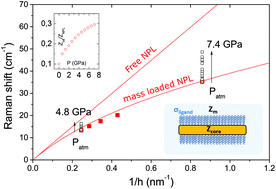Environmental effects on the natural vibrations of nanoplatelets: a high pressure study
Abstract
Resonant acoustic modes from ultrathin CdS colloidal nanoplatelets (NPLs) are probed under high pressure using low frequency Raman spectroscopy. In particular we focus on the characterization of the recently evidenced mass load effect that is responsible for a significant downshift of the NPL breathing frequency due to the inert mass of organic ligands. We show that a key parameter in the observation of the mass effect is whether the surrounding medium is able to support THz acoustic wave propagation, at a frequency close to that of the inorganic vibrating core. At low pressures, surface organic molecules show a single particle-like behavior and a strong mass effect is observed. Upon pressure loading the ligands are compacted together with the surrounding medium and slowly turned into a solid medium that supports THz acoustic phonons. We observe a continuous transition towards a fully embedded NPL with a frequency close to that of a freely vibrating slab and a progressive loss of the mass effect. The quality factor of the detected vibration significantly decreases as a result of the appearance of a “phonon-like” behavior of the environment at the origin of damping and energy dissipation.



 Please wait while we load your content...
Please wait while we load your content...